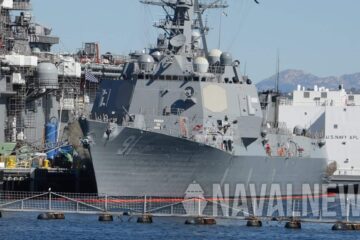Instead of a LCS frigate variant, the U.S. Navy opted to issue a RFP for a Future Guided Missile Frigate (FFG(X)). Nonetheless, the Navy has taken steps to improve the lethality, survivability, and weapons’ range of the LCSs with the following Mission Packages (MP).
The Lockheed Martin Freedom-class LCS Upgrade

Lockheed Martin, builders of the Freedom-class LCS, showed a scale model at Surface Navy Association (SNA) 2019 that featured Government Furnished Equipment (GFE) that will be installed in the U.S. Navy’s Future Frigate (FFG(X)) as a suggestion to improve the lethality and survivability of the Freedom-class LCSs. The GFEs include four Nulka missile decoy launchers, eight Norweigian Kongsberg 100+ nautical mile Naval Strike Missile launchers behind the 57mm turret, two SEWIP 3 jamming modules, an 8-cell full-length VLS module able to launch Tomahawk cruise missiles and Evolved Sea Sparrow Missiles (ESSM air defense missiles, four per cell or up to 32 ESSMs total in the two Mission Modules), and the Longbow Hellfire Missile Module.
According to NAVSEA’s late 2019’s responses to emailed questions, the United States Navy has not fully explored or studied the Lockheed Martin’s options for adding VLS cells to the Freedom-class Littoral Combat Ships (LCS).
The U.S. Navy’s current plans are less ambitious than what Lockheed Martin proposes with the SNA 2019 ship model display although some suggestions will be implemented. “LCS is intended to have one of three LCS Mission Packages installed for focused mission capability, which include Mission Packages (MPs) focusing on surface warfare (SUW), anti-submarine warfare (ASW) and mine countermeasures (MCM),” said Alan Baribeau, Public Affairs for NAVSEA.
“The SUW MP consists primarily of a vertically-launched Longbow Hellfire missiles, 30mm guns and Visit, Board, Search and Seizure (VBSS) equipment, along with aviation assets. The ASW MP consist primarily of a Variable Depth Sonar, sonobouys and aviation assets. MCM MP is made up of various unmanned surface, underwater and aerial vehicles and sensors to detect, classify and defeat threat mines. LCS also has organic mission capability, regardless of which MP is installed. The Navy is upgrading this organic capability for both LCS variants with a focus on improvements to lethality and survivability. Some of the specific upgrades the Navy is investing in to address lethality include Over-the-Horizon missiles and the next-generation Electronic Warfare suite. The program is also concentrating on transitioning to a common combat management system for both LCS variants. In order to facilitate this transition, the Navy intends to replace combat system elements that are unique contractor furnished equipment with government furnished equipment. This effort significantly improves LCS maintainability, reliability, and reduces operating and sustainment costs through common equipment sourcing, sparing, and training.”

As of December 2019, the U.S. Navy has no requirement for the LCSs to be fitted with the Vertical Launch System 8-cell Mission Module plug-in (or 16 VLS cells in place of the two 30mm Bushmaster autocannon turrets in the SUW MP) and is not actively seeking any development.
“Analysis would be required to determine feasibility of outfitting LCS (both variants) with VLS. The Navy does not currently require this capability for LCS, and no, a RFP has not been released for the implementation of VLS on LCS,” replied Baribeau who added, “The Navy plans to field the Naval Strike Missile (NSM) to the LCS class ships to provide anti-ship capability in addition to the Surface Warfare mission package. The Navy has not studied other missiles for the NSM launcher on LCS [or fitting in a different missile container (such as ESSM, LRASM, Tomahawk, or ASROC on the NSM launch racks].
Despite the LCS’s ASW Mission Package having Variable Depth Sonar and sonobuoys, NAVSEA reported that there currently does not exist a requirement for deck-mounted torpedo tubes (such as the Mark 32 triple-torpedo tubes) in the ASW Mission Module Package. The LCS’s ASW weapons prosecutor would remain the MH-60R helicopter utilizing AQS-22 ALFS dipping sonar, sonobuoys, FLIR, ESM, surface surveillance/periscope detection radar, and MK54 torpedoes for Strike Group and Theater-level ASW.
USS Independence-class LCS as an U.S. Marine Corp Amphibious Transport



Another feature of the LCSs is the large Mission Bay Deck specific to the Austal built USS Independence-class LCS. The USS Independence-class with its large internal Mission Bay Deck and tie-down anchors, could, in theory, transport U.S Marine (and U.S. Army) ground combat vehicles small enough to fit through the side door and light enough for the Mission Bay Deck. Vehicles such as USMC M1A1 120mm Main Battle Tanks, AAV7P tracked amphibious assault vehicles, 8X8 Light Armored Vehicles, 6X6 cargo MTVRs, MRZRs, ATVs, M-Gators, 4X4 HMMWVs, HiMARS rocket launchers, and 4X4 M-ATVs and JLTVs, and have either CH-53 cargo helicopters transport the lighter vehicles internally or externally, or drive the heavier combat vehicles to land via the side ramp. As of December 2019, NAVSEA said that the LCSs currently have not transported ground combat vehicles, nor is it part of the mission requirement of the LCS. NAVSEA stated that a study is required in order to transport vehicles aboard the Independence-class LCS.







One Comment
Pingback : Buletin naval: verde pentru o navă amfibie ușoară la USMC - Romania Military